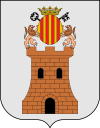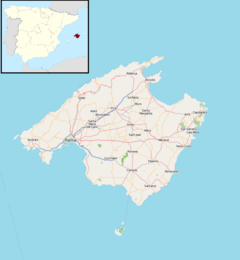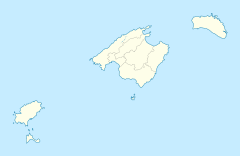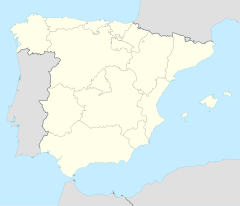Algaida facts for kids
Algaida is a charming town and municipality located on Majorca, one of Spain's beautiful Balearic Islands. It covers an area of about 90 square kilometers and is home to over 5,500 people. This lovely place is known for its rich history and interesting sights.
Quick facts for kids
Algaida
|
||
|---|---|---|
|
Municipality and town
|
||
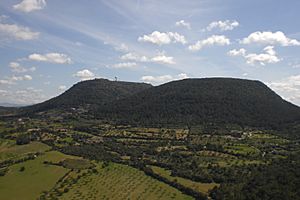 |
||
|
||

Map of Algaida in Mallorca
|
||
| Country | ||
| Autonomous Community | ||
| Province | ||
| Island | Majorca | |
| Comarca | Pla de Mallorca | |
| Area | ||
| • Total | 89.78 km2 (34.66 sq mi) | |
| Population
(2018)
|
||
| • Total | 5,529 | |
| • Density | 61.584/km2 (159.501/sq mi) | |
| Demonym(s) | Algaidins | |
| Time zone | UTC+1 (CET) | |
| • Summer (DST) | UTC+2 (CEST) | |
Contents
Exploring Algaida's Geography
Algaida is located in the southeastern part of Majorca. It is about 22 kilometers away from Palma, the island's capital. You can easily reach it by following the main highway towards Manacor.
Mountains and Hills
The area around Algaida has six small mountains. The most famous and tallest is Puig de Randa. It stands at 543 meters high. This mountain is a special landmark in the region.
Weather in Algaida
Rainfall can happen throughout the year in Algaida. July is usually the driest month. Even though it's an island, the weather can change.
A Look into Algaida's History
The name Algaida comes from an old Arabic word, al-gaida. This word means "the Base." The municipality of Algaida includes three smaller communities: Algaida, Pina, and Randa.
Early Records
Algaida was first mentioned in official records in the year 1232. This shows that people have lived here for a very long time.
The Special Place of Randa
Randa is one of the most well-known communities in the area. It is home to the flat-topped mountain called Puig de Randa. On this mountain, you can find three quiet monasteries.
Who Lives in Algaida?
The people who live in Algaida are called Algaidins. As of 2018, the total population of the municipality was 5,529.
Population of Communities
The population is spread out among the different communities. Here's how many people lived in each main area in 2005:
- Algaida (town): 2,423 inhabitants
- Pina: 391 inhabitants
- Randa: 62 inhabitants
Must-See Places in Algaida
Algaida and its surrounding areas offer many interesting places to visit. From ancient monasteries to unique shops, there's a lot to explore.
Sanctuaries on Puig de Randa
The Puig de Randa mountain is home to several important religious sites:
- Santuario de Nuestra Señora de Gracia: This is a hermitage from the 15th century. It looks like a swallow's nest built right into the side of a cliff.
- Santuario de Sant Honorat: Located on the second level of the mountain, this sanctuary dates back to the 14th century.
- Santuario Nuestra Señora de Cura: At the very top of the mountain, this sanctuary has been a Franciscan hermitage since 1275. It was once home to Ramon Llull, a famous philosopher and scholar from Majorca. The Puig de Randa also has the Ramon Llull Museum and a school.
Sights in Algaida Town
In Algaida town itself, you can find places like Punxuat and Albenya. There's also the pilgrimage chapel of Mare de Déu de la Pau de Catellitx. You might also spot several old windmills.
One special place is Gordiola, the oldest glass blower's factory in Majorca. It's just outside Algaida, on the way to Palma. Here, you can watch skilled glass-blowers create beautiful art pieces.
Exploring Randa Village
The village of Randa has its own attractions:
- The parish church of the Immaculada and Ramon Llull.
- The cross of Randa and the cross of Sant Honorat.
- The Randa springs.
- The Sanctuary of Mare de Déu de Cura.
- Amazing panoramic views from the Randa mountain.
Highlights of Pina
Pina is home to the parish church of Sants Cosme i Damià. You can also visit the convent and a local well.
On the main road to Manacor, you'll see a large black bull sign. This bull is a symbol for the Andalusian sherry-distiller Osborne. It's the only one of its kind on Majorca. This bull is now protected across Spain as a "National Cultural Icon."
See also
 In Spanish: Algaida para niños
In Spanish: Algaida para niños
Images for kids


